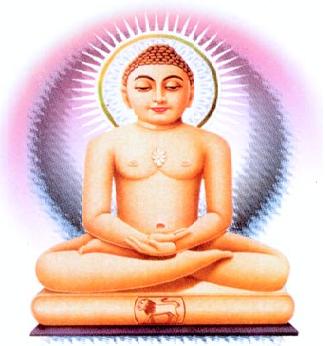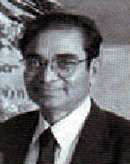
Jain Agam Literature
1. BackgroundLord Mahavir's preaching was orally compiled by his disciples into many texts. This knowledge was orally transferred from acharyas (gurus) to the disciples over the course of about one thousand years. In olden times, monks strictly followed the five great vows of Jainism. Even religious scriptures were considered possessions and therefore knowledge of the religion was never documented. Also, during the course of time many learned acharyas (elder monks) complied commentaries on the various subjects of the Jain religion.
Around 500 A.D., which was one thousand years after Lord Mahavir's nirvana (death), Jain acharyas realized that it was extremely difficult to keep memorizing the entire Jain literature complied by the many scholars of the past and present. In fact, significant knowledge was already lost and the rest was polluted with modifications and errors. Hence, they decided to document the Jain literature as known to them. In this time period two major sects, namely Digambar and Swetambar, were already in existence. A thousand years later (1500 A.D.), the Swetambar sect divided into three subsects known as Swetambar Murtipujak, Sthanakvasi, and Terapanthi. Differences exist among these sects in their acceptance of the validity of the documented Jain scriptures and literature.
2. Jain Literature Jain literature is classified into two major categories:- Agam Literature:
This consists of original scriptures complied by Gandharas and Srut-kevalis. They are written in the Prakrit language. - Non-agam Literature:
This consists of commentary and explanation of Agam literature and independent works, complied by elder monks, nuns, and scholars. They are written in many languages such as Prakrit, Sanskrit, Old Marathi, Gujarati, Hindi, Kannad, Tamil, German, and English.
- Ang-agams or Ang-pravista-agams
These texts contain the direct preaching of Lord Mahavir. They were complied by Ganadharas. - Ang-bahya-agams (outside of Ang-agams)
These texts are expansions of Ang-agams. They were complied by Srut-kevalis.
Lord Mahavir's preaching was methodically compiled by his followers into many texts. These texts are collectively known as Agams, the sacred books of the Jain religion. Hence, the Jain religion does not have one sacred book like the Bible or Koran, but it has many books complied by many followers.
Ang-agams:4. Digambar Jain Literature:Lord Mahavir's immediate disciples were known as Ganadharas. All Ganadharas possessed perfect knowledge (keval-jnan). They orally complied the direct preaching of Lord Mahavir into twelve main texts (sutras). These texts are known as Ang-agams. Hence the Ang-agams are the oldest religious scriptures and the back bone of Jain literature.
The twelfth Ang-agam is called Drastivad. The Drastivad consists of fourteen Purva texts, also known as Purvas or Purva-agams. Among Ang-agams, Purvas were the oldest sacred texts. All Jain sects believe that knowledge of the Purvas (Drastivad) were gradually lost starting two hundred years after Lord Mahavir's nirvan (death). However, the subject matter of the Purvas has been referenced by other Jain scriptures and literature.
The Digambar Jain sect also believes that the remaining eleven Ang-agams were gradually lost. All Swetambar Jains believe that the proper meaning and the original intent of the eleven Ang-agams survived and were properly documented by elder monks one thousand years after Lord Mahavir's nirvan.
Ang-bahya-agams:
Sect Number of Ang-agams
AcceptedPresent Status Digambar 11
All are lost Swetambar Murtipujak 11
Available Swetambar Sthanakvasi 11
Available Swetambar Terapanthi 11
Available Monks who had knowledge of a minimum of ten Purvas were known as Srut-kevlis. The Srut-kevlis wrote many texts (sutras) expanding the subject matter defined in the Ang-agams. Collectively these texts are called Ang-bahya-agams meaning outside of Ang-agams.
The different Jain sects accept different numbers of Ang-bahya texts. However the Digambar sect believes that they were also gradually lost starting about two hundred years after Lord Mahavir's Nirvan.
Classification of Ang-bahya-agams:
Sect Number of Ang-bahya-agams
AcceptedPresent Status Digambar 14
All are lost Swetambar Murtipujak 34
Available Swetambar Sthanakvasi 21
Available Swetambar Terapanthi 21
Available The Swetambar sect has divided Ang-bahya-agams into the following categories:
Classification Summary:
The scriptures which provide further explanation of Ang-agams are called Upang-agams. There are 12 Upang-agams accepted by all Swetamber sects.
The scriptures which are essential for monks and nuns to study in the earlier stages of their monkhood are called Mool-sutras. The Swetambar Murtipujak sect accepts 4 Mool-sutras texts but the Sthanakvasi and Terapanthi sects accept only 3 texts.
The scriptures which enhance or decorate the Ang-agams are known as Chulika-sutras or Sutras. There are 2 Chulika-sutras accepted by all Swetamber sects.
The scriptures which describe independent or miscellaneous subjects of the Jain religion are known as Prakirna-sutra. The Swetambar Murtipujak sect accepts 10 Prakirna-agams texts but none are accepted by the Sthanakvasi and Terapanthi sects.
Agams Swetambar Murtipujak Sect Sthanakvasi/Terapanthi Sect Upang-agams 12
12 Chhed-sutra-agams 6
4 Mool-sutra-agams 4
3 Chulika-sutra-agams 2 2 Prakirna-agams 10 none Total Ang-bahya-agams 34
21
The Digambar sect believes that there were 25 Agam-sutras (11 Ang-agams + 14 Ang-bahya-agams) complied from the original preaching of Lord Mahavir. However, they were gradually lost starting about two hundred years after Lord Mahavir's nirvana. Hence the existing Agam-sutras (which are accepted by the Swetambar sects) are not accepted by them as authentic scriptures.
In the absence of authentic scriptures, Digambars use the following literature as the basis for their religious practice. These scriptures were written by great Acharyas (scholars) from 100 to 800 A.D. and are based on the original Agam Sutras.
- Two Main Texts:
- Shatkhand-agam
- Kasay-pahud
- Four Anuyogas:
- Pratham-anuyoga (Dharma-kath-anuyoga) - Religious Stories
- Charn-anuyoga - Conduct
- Karan-anuyoga (Ganit-anuyoga) - Description of the Universe
- Dravy-anuyoga - Philosophy
Shatkhand-agam:Summary:This Digambar scripture is also known as Maha-kammapayadi-pahuda or Maha-karma-prabhrut. It was written by two Acharyas; Pushpadant and Bhutabali around 160 A.D. The second Purva-agam named Agraya-niya was used as the basis for this scripture. The scripture contains six volumes. Acharya Virsen wrote two commentary texts, known as Dhaval-tika on the first five volumes and Maha-dhaval-tika on the sixth volume of this scripture, around 780 A.D.
Kashay-pahud (Kashay Prabhrut):This scripture was written by Acharya Gunadhara. The fifth Purva-agam named Jnan-pravad was used as a basis for this scripture. Acharya Virsen and his disciple, Jinsen, wrote a commentary text known as Jaya-dhaval-tika around 780 A.D.
Four Anuyogas:
- Pratham-anuyoga (Dharma-kath-anuyoga) - Religious Stories
This anuyoga consists of the following texts which contain religious stories, art, literature, history, poetry, and like literature.
Name Author Time Padma-puran Ravisen
650 A.D. Harivamsa-puran Jinsen II
783 A.D. Adi-puran Jinsen II
783 A.D. Uttar-puran Gunabhadra 879 A.D.
- Charn-anuyoga - Conduct
This anuyoga consists of the following texts which contain principles of observances, conduct, behavior, and like literature.
Name Author Time Mulachar Vattaura
600 A.D. Trivarnachar Vattaura 600 A.D. Ratna-karanda-shravak-achar Samantabhadra
600 A.D.
- Karan-anuyoga (Ganit-anuyog) - Description of the Universe
This anuyoga consists of the following texts which contain geography, mathematics, astronomy, astrology, and like literature.
Name Author Time Surya-prajnapti Unknown
- Chandra-prajnapti Unknown
- Jaya-dhaval-tika Virsen/Jinsen
780 A.D. Gommat-sar Nemichandra Siddhant Chakravarti 1000 A.D.
- Dravy-anuyog - Philosophy
This anuyoga consists of the following texts which contain philosophical doctrine, theories, Tattvajnan, and like literature.
Name Author Time Niyamasar Kunda-kunda
100 A.D. Panchastikaya Kunda-kunda
100 A.D. Pravachanasar Kunda-kunda 100 A.D. Samaya-sara Kunda-kunda 100 A.D. Tattvartha-sutra Umaswami 200 A.D. commentary by Samantabhadra 600 A.D. commentary by Pujyapad 700 A.D. commentary by Akalank 750 A.D. commentary by Vidyanand 800 A.D. Aptamimamsa Samantabhadra 600 A.D. commentary by Akalank
750 A.D. commentary by Vidyanand 800 A.D.
The Jain literature which was complied by Ganadharas and Srut-kevlis is known as Agam literature. These texts are the holy scriptures of the Jain religion.
The Agam Sutras show great reverence for all forms of life and strict codes of vegetarianism, asceticism, nonviolence, and opposition to war. The existing Agam Sutras are accepted as the authentic preaching of Lord Mahavir by the Swetambar sects, but the Digambar sect does not accept them as authentic. Digambars follow two main texts (Shatkhand Agam and Kasay Pahud) and four Anuyogs (consisting of more than 20 texts) written by great Acharyas (scholars) from 100 to 800 A.D.
All other Jain literature is known as Non-agam literature.
Summary Table:| Category | Accepted by: | ||
| Digambar | Swetambar Murtipujak | Sthanakvasi/Terapanthi | |
| Ang-agams | 11 | 11 | 11 |
| Ang-bahya-agams | 14 | 34 | 21 |
| Total Agams | 25 | 45 | 32 |
Classification of Ang-bahya-agams of Swetamber Sects:
| Agams | Swetambar Murtipujak Sect | Sthanakvasi/Terapanthi Sect |
| Upang-agams | 12 | 12 |
| Chhed-sutra-agams | 6 | 4 |
| Mool-sutra-agams | 4 | 3 |
| Chulika-sutra-agams | 2 | 2 |
| Prakirna-agams | 10 | none |
| Total Ang-bahya-agams | 34 | 21 |
- Ang-agams:
Ang-agams are the oldest religious scriptures and the back bone of Jain literature.
This agam explains the subtle knowledge of soul, matter, and other related subjects. 36000 questions and answers are presented in discussion form. It is the largest of the eleven Ang-agams.
- Upang-agams:
The scriptures which provides further explanation of Ang-agams are called Upang-agams.
- Chhed Sutra Aagams:
The subject matter described in the Chhed-sutras is for monks and nuns and not for lay people. It relates to the conduct and behavior of monks and nuns. It also explains how they can repent for their sins and mistakes.
- 20 places of Asamadhi
- 21 powerful faults bringing weakness in conduct
- 33 Ashatanas of Guru
- 8 Sampadas of Acharyas and their kinds
- 10 places of Chitta Samadhi
- 11 Pratimas of Sravaka
- Bhiksu Pratimas
- KALPASUTRA - recited during the Paryushanas
- 30 places of Maha Mohaniya karma bandhana
- 9 Nida nas (Niyane)
- Mool-sutras:
The scriptures which are essential for monks and nuns to study in the early stages of their ascetic life are called Mool-sutras.
- Chulika-sutras or Sutras:
The scriptures which enhance or decorate the Ang-agams are known as Chulika-sutras or Sutras.
- Prakirna-agams:
The scriptures which describe independent or miscellaneous subjects of the Jain religion are known as Prakirna-sutra.
- Lord Arihant- God in the form of human being
- Lord Siddha - God in the form of pure consciousness
- Sadhu - All monks
- Dharma - Religion
* Note: These 13 Agams are not recognized by the Sthanakvasi and Terapanthi Jain sects
 Pravin K. Shah
Pravin K. Shah